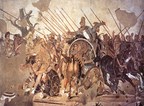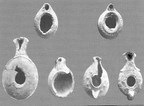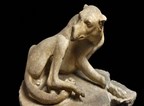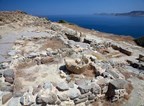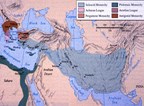The Hellenistic civilization existed during the period from from 232 BC to 146BC. It represents the zenith of Greek influence and it was preceded by the classical Hellenic period and was followed by the Roman rule. The Hellenistic civilization was spread as a result of the conquest of Alexander the Great. Hellenistic kingdoms were established throughout Asia and Africa. The conquest of these lands resulted in the spreading of Greek culture and languages. Hellenistic civilization represents a fusion of ancient Greece along with that of the middle east, Asia and near east. The Hellenistic times were characterized by the New Greek colonization which established cities and kingdoms in Africa and Asia. These cities were then composed of colonies where people from across Greece lands came and settled.
Alexander had captured the whole Persian Empire and had taken over the throne of Persian King Darius 3. As Alexander died at a young age, chaos took place for overtaking his throne, and thus his empire started to decline. The major lands of Hellenistic times include Greece, Cyprus, Italy, Asia, Egypt, France, Arabian Peninsula and Iberia. The Greek referred Bahrain as Tylos, which was the center of trade-in pearls; it was discovered by Nearchus who was serving under Alexander. Tylos was included in the Persian Empire for 6th to 3rd century and was a center of planting cotton and it was known for making walking canes which was later carried into Babylon as a custom.
Many scholars of the 19th century contended that the Hellenistic times represented a cultural decline from the brilliance of the ancient Greece. Though this content is now seen as unfair and has no meanings at all. Even commentators of those times have seen the end of a cultural era which could not be matched again or brought back ever again. With the decline of the Greek policies, and the establishment of monarchical states in the region, the environment and social freedom in which to excel may have been reduced or completely destroyed. In some fields Hellenistic culture thrived with the preservation of its past. The states of the Hellenistic civilization were deeply related to the past and its seemingly lost beauty. Athens restored their position as the most prestigious seat of higher education, especially in the domains of philosophy and rhetoric, with large libraries and wide varieties of books.
Alexandria was the second most important education center. The Library of Alexandria had a collection of 700,000 volumes. The city of Pergamon became a major center of production of books; it possessed a library of 200,000 volumes. In the island of Rhodes a finishing school for politics and diplomacy was established. The wide spread of Greek culture throughout Asia was responsible for the development of cities. Settlements such as Ai-Khanoum which was located on trade routes, this location allows the cultures to spread and mix. Greek style temples became common and the Greek buildings such as gymnasia became common among the cities. Many Greek statutes, clothes,and jewelry became common in many areas of Greece. This wide spread of Greek culture and modernization all happened during the period of Hellenistic civilization.
The fall of the Hellenistic period was in 146 BC. It happened when the Roman Republic conquered most of mainland Greece, and had conquered all of ancient Macedon. By that time the rise of Rome to absolute political prominence in the Mediterranean on the final stage and this marked the start the Roman period. When the final Hellenistic kingdom of Egypt was conquered by Rome this marked the absolute end of the power of the Hellenistic civilizations. From the 2nd to 1st century BC, the Romans had conquered Greece piece by piece until the complete conquest of Egypt around 30 BC. The Roman art, literature and culture were based upon the models of the Hellenistic period.
Hellenistic civilization is full of arts and science. Their astronomy, art and jewelry were famous all around the world. During the Hellenistic period many different schools of thought were established. Hellenistic philosophy experienced an age of eclecticism, a new view awakening of the diverse knowledge and theories common in the present culture. People who contributed in the development of Hellenistic philosophy were the Greeks, Egyptians, Syrians, Arabs and Romans.
The Hellenistic civilization was the one which established educational centers in Alexandria, Egypt and Antioch in Syria along with Greek speaking populations across several monarchies and cities. Hellenistic science differed from Greek science in two ways. It was from the cross-fertilization of Greek ideas with those that had developed and were modern. Secondly it was supported by royal patrons in the kingdoms founded by the successors of Alexander. The city of Alexandria in Egypt Was important to Hellenistic science, being a major scientific research center in the 3rd century BC. Two institutions were established there along with the Library and the Museum.
Scholars and historians focused on the Hellenistic period over the course of the 19th century; historians see the period of focus as a reflective image of the current times. Many 19th century scholars contended that the Hellenistic period represented a cultural decline from the brilliance and intelligence of the ancient Greece. Though this comparison meaningless, it has been discovered that even commentators of the time saw the end of a cultural era which cannot be matched or brought back again. This may be linked with the style of government and policies and so with the decline of the Greek policies and the establishment of monarchies, different states and cities, the environment had changed leading to the reduction of social, political and religious freedom. Many people had migrated to other cities and settled there. The Romans had adopted many things from the Hellenistic civilization. Many items from the Hellenistic era are preserved and displayed in many museums. The largest attraction of the Hellenistic civilization is their jewelries and their artifacts.
